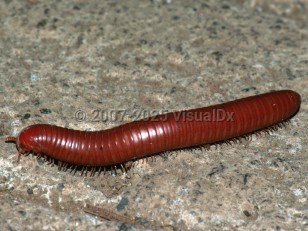Millipede dermatitis in Adult
Alerts and Notices
Important News & Links
Synopsis

Millipedes are elongated arthropods, class Diplopoda, that have 2 pairs of legs per body segment (centipedes have 1 pair per body segment). Approximately 7 000 species of millipedes are found worldwide in a variety of habitats. They live on the ground, are slow moving, feed on decaying vegetation, and are secretive, although, at times, there is mass migration.
Millipedes have no venom or apparatus for injecting venom (no fangs, biting mouthparts, or stingers). Rather, their means of defense is to squirt, up to 80 cm, a caustic liquid from pores along their sides. The liquid is composed of a variety of chemicals, such as hydrogen cyanide, phenol, and organic acids, which can induce a contact dermatitis in humans.
Skin exposure to millipede secretions can cause a burning sensation, inflammation, and a tanning discoloration of the skin that may subsequently blister and exfoliate, resulting in pigmentation and scarring. Ocular exposure can cause immediate pain and tearing and may lead to chemosis, blepharospasm, periorbital edema, conjunctivitis, keratitis, and corneal ulceration. Blindness is reported in the literature but is not well substantiated. No human fatalities have been associated with millipede secretions.
Millipedes have no venom or apparatus for injecting venom (no fangs, biting mouthparts, or stingers). Rather, their means of defense is to squirt, up to 80 cm, a caustic liquid from pores along their sides. The liquid is composed of a variety of chemicals, such as hydrogen cyanide, phenol, and organic acids, which can induce a contact dermatitis in humans.
Skin exposure to millipede secretions can cause a burning sensation, inflammation, and a tanning discoloration of the skin that may subsequently blister and exfoliate, resulting in pigmentation and scarring. Ocular exposure can cause immediate pain and tearing and may lead to chemosis, blepharospasm, periorbital edema, conjunctivitis, keratitis, and corneal ulceration. Blindness is reported in the literature but is not well substantiated. No human fatalities have been associated with millipede secretions.
Codes
ICD10CM:
T63.411A – Toxic effect of venom of centipedes and venomous millipedes, accidental, initial encounter
SNOMEDCT:
403154004 – Millipede burn
T63.411A – Toxic effect of venom of centipedes and venomous millipedes, accidental, initial encounter
SNOMEDCT:
403154004 – Millipede burn
Look For
Subscription Required
Diagnostic Pearls
Subscription Required
Differential Diagnosis & Pitfalls

To perform a comparison, select diagnoses from the classic differential
Subscription Required
Best Tests
Subscription Required
Management Pearls
Subscription Required
Therapy
Subscription Required
References
Subscription Required
Last Updated:02/19/2018
Millipede dermatitis in Adult

